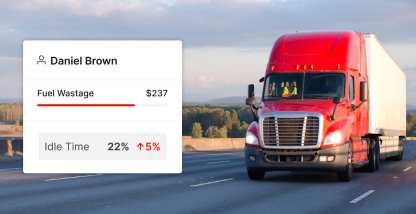A small fleet doesn’t necessarily mean easier operations. People who manage them may have to face unique management challenges in the form of limited human and financial resources.
Providing customers with the best service you can, managing a limited budget, and staying competitive in the industry can be overwhelming.
5 challenges of running a small fleet and how to overcome them.
1. Increasing fuel efficiency
Sometimes, because of budget and resource constraints, small fleets may fail to enforce the importance of fuel efficiency. They also may not have much to spend regularly on driver coaching programs and ensure that drivers stay efficient.
For a truck that consumes $70,000 worth of fuel, it is estimated that $5,600 is wasted on idling. Small fleets with a limited budget simply cannot afford this.
You can install a fleet management system that tracks excessive idling across the fleet. For instance, the Motive ELD solution helps you identify drivers who idle for too long or too frequently. Fleet managers can view idling and utilization rates in the Motive Dashboard for the entire fleet or break it down by vehicles or drivers.
A feature-rich fleet management system like this gives small fleet administrators all the information they need to increase efficiency and profitability.
By using this data, fleet managers can identify drivers who require coaching and improve utilization rates. You can also try a more hands-on approach when it comes to route optimization to save even more fuel.
2. Keeping driver turnover rate in check
A high driver turnover rate is a problem that most fleets face, especially because the trucking industry is facing a severe shortage of drivers.
According to the Upper Great Plains Transportation Institute, the average cost of turnover per driver is $8,243. For a small fleet that needs to make every penny count, a high driver turnover rate is a huge blow.
As most small fleets don’t have the big budget of large corporations, they may find it even more difficult to compete with them in terms of competitive packages, better salaries, and perks.
However, there are ways that small fleets keep the driver turnover rate in check. Set up a two-way feedback/communication channel to stay in touch with drivers and get their honest feedback. Drivers may feel more content when they have a way to communicate their concerns.
Moreover, staying in close touch with drivers especially during the first few months of their employment is also very important.
Studies reveal that 57% of newly hired drivers leave within the first six months. By refining the driver recruitment process and creating a better driver onboarding system, small fleets can improve the early driver turnover rate.
3. Taking care of vehicle maintenance
Small fleets may not have as many vehicles as a large trucking business. If one vehicle breaks down, schedules can be thrown off track, and a large chunk of your operations may come to a halt.
Being on top of vehicle maintenance becomes an important aspect of fleet management.
First, you have to create and maintain a schedule for regular maintenance of your vehicles. Second, you also need to educate drivers about the importance of vehicle maintenance and pre-trip inspections. You can also use an automated system to stay on top of vehicle maintenance.
For instance, the Motive ELD solution automatically monitors fault codes through its direct connection to onboard vehicle diagnostics. Fleet managers receive a fault-code notification as soon as an issue occurs. With Motive, you can also customize DVIRs to meet your specific vehicle maintenance requirements.
4. Holding drivers accountable
Driver management may feel more personal in a small fleet. Identifying at-risk or low-performing drivers and being honest about those issues may feel particularly difficult when you only have a few drivers in your fleet.
Open communication is critical here. Moreover, creating automated systems with the help of ELDs and fleet management software may also help reduce friction. You can also start an internal newsletter that highlights the best-performing drivers and the safety statistics of the fleet. This will not only motivate drivers, but it may also make them more focused on improving fleet safety and working in unison with the management to achieve organizational goals.
You can also install front-facing dash cams and incorporate those videos in the driver coaching program. Videos of accidents or critical safety events may make conversations and coaching drivers much easier.
For more information, check out the Motive Smart Dashcam, and how it helps fleets.
5. Making use of technology
Technology is great, but it isn’t always an option for smaller fleets with limited resources. Apart from the cost of purchasing and implementing technological products and fleet management software, driver onboarding and training are other major issues that small fleets may find challenging.
There are cost-effective options available for smaller fleets out there. The best way is to find a fleet software system that includes electronic logs and telematics.
Find the right fleet management solution
A small fleet may have a few more challenges to face. With the right tools and strategies, you can overcome those challenges, become more competitive, and improve the bottom line of your company. See how Motive can help.









